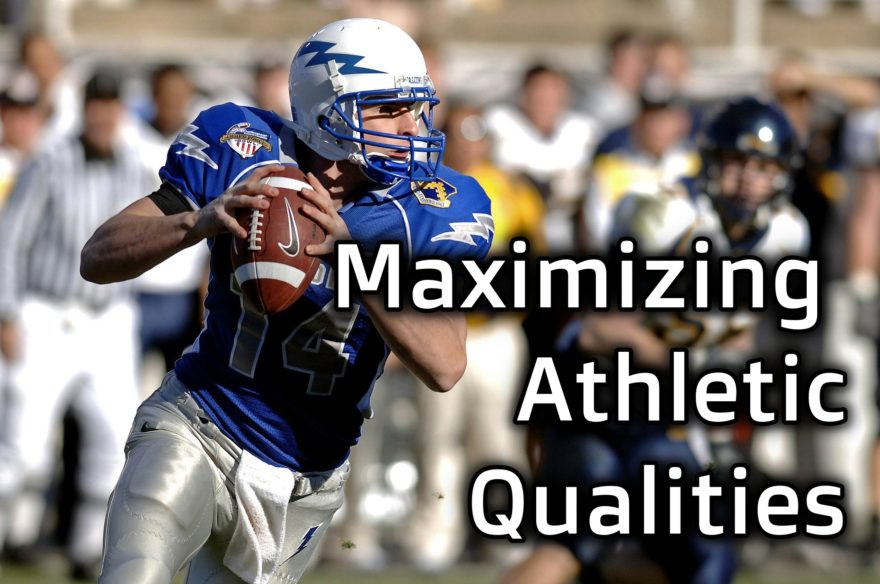Table of Contents
How improving your movement can affect speed, agility, and more!
You got an athlete who is slow as all hell. Maybe they can’t get low enough in a cut, are slow at accelerating, or just stink at producing force.
Is there a way to increase their athleticism?
To do so we need one MAJOR KEY!

The stretch-shortening cycle. You know, that whole eccentric, amortization, concentric thang?
What if you lost a piece of this cycle? What if you couldn’t become eccentric in the spots you needed to because your hip mobility is broke AF?
Fortunately for you, we can apply many of the movement option concepts in the athletic realm, and get dope results in the process.
Want to teach your peeps to be more explosive and dynamic in their sports?
Then check out Movement Debrief Episode 129 below!
Watch the video below for your viewing pleasure, or listen to the podcast if you can’t stand the sight of me 🙁
and the audio version:
If you want to watch these live, add me on Instagram.

 t
tShow notes
Check out Human Matrix promo video below:
Below are some testimonials for the class:
Want to sign up? Click on the following locations below:
October 3rd-4th, Ann Arbor, MI (Early bird ends September 6th at 11:55pm!)
November 7th-8th, Charlotte, NC (Early bird ends October 11th at 11:55pm!)
February 20th-21st, 2021, Atlanta, GA (Early bird ends January 17th at 11:55 pm!)
May 1st-2nd, 2021, Minneapolis, MN (Early bird ends April 4th at 11:55pm!)
May 29th-30th, 2021 Boston, MA (Early bird ends April 25th at 11:55pm!)
Dickinson College in Carlisle PA (POSTPONED DUE TO COVID-19) [Approved for 14 Category A CEUs for athletic trainers]
Montreal, Canada (POSTPONED DUE TO COVID-19) [6 CEUs approved for Athletic Therapists by CATA!]
Or check out this little teaser for Human Matrix home study. Best part is if you attend the live course you’ll get this bad boy for free! (Release date not known yet 🙁
Here is a signup for my newsletter to get nearly 5 hours and 50 pages of content, access to my free breathing and body mechanics course, a free acute:chronic workload calculator, basketball conditioning program, podcasts, and weekend learning goodies:
[yikes-mailchimp form=”1″ submit=”Get learning goodies and more”]
The seated box jump to a box is a great starting point for introducing both force production and absorption. The box basically allows you a tucked start, then minimizes the eccentric demands to allow for an effect jump:
The Guide to Physical Therapy School – If you are interested in attending physical therapy school, want to pick the best place, and get the most out of it, this is the post for you.
Sawbones – This is the website where I get all my bones in the Movement Debrief.
If you want to learn how to stack, you’ll want to check out this post.
How to Improve Agility and Cutting Mechanics with Lunge Variations – This was an awesome video by Daddy-O Pops himself Bill Hartman where he outlines how to manipulate trunk rotation to improve your cutting skills. If you feel “stuck” in a hip, these are great variations.
If you want to improve shifting into a hip to help with loading, then you could try this low-intensity move to acquire the skill:
For a higher intensity variation, try this move, which can also bias some trunk rotation:
To better explode out of a got, or to “get out” of the hip, this low-intensity variation is great:
For a high-intensity variation, try this move:
Lee Taft – Lee is THE GUY for all things agility training. You definitely want to check him out. If you want to peep a course review I did on Lee WAY back in the day, you can read that here.
Derek Hansen – He is my go-to resource on all things sprint training. I reviewed a private course he did here.
Agility – This is my compendium of several resources that are agility-related.
Acceleration – This is my compendium of several resources that are acceleration-related.
Elevate Sports Performance and Healthcare – This is the facility I work out of in wonderful Las Vegas.
Brian Chandler – The owner of Elevate, and one of the top 50 coaches in Golf Digest. Has a vast experience working with elite golfers
Brad Thompson – Our Strength and Conditioning director at Elevate. He’s a beast at all things golf.
Force Absorption and Production of Infrasternal Angles
Question: From the point of view of sports training, which ISA would be more efficient in generating force and which in absorbing it (Acceleration Vs Deceleration)? Why?
Answer: The #majorkey is understanding what type of contractile action is needed to both generate and absorb force.
Force absorption = eccentric
Force production = concentric
Absorbing force requires accepting the forces imparted on a body, and an eccentric contraction is needed for that acceptance. Whereas producing force requires going against the forces imparted on the body, thus a concentric contraction.
Assuming no secondary compensations, there are certain infrasternal angles (ISA) that have greater eccentric ventral cavity bias, and some that have a concentric bias:
Narrow ISA = eccentric bias = Force acceptor
Wide ISA = Concentric bias = Force producer
Now there is a HUGE (HYOOGE? SP) caveat to this: Assuming no secondary compensations.
This is a poor assumption because it seems like all the fam nowadays have compensations left and right. You can have narrows that develop concentric biases that make force absorption whack, and you can have wides that develop weird eccentric biases that make their force production weaksauce.
Moral of the story? Don’t assume…fam.
Alright, so we can’t assume certain presentations will be good at anything, but are their useful heuristics to follow for improving absorption and production?
I’M GLAD YOU ASKED!
There are some useful strategies that can get your force utilizing on point. Here’s what I recommend:
Improve force absorption by:
- Squatting
- High depth shifting
- Slow eccentrics
- Drop catches
- Reaching
Improve force production by:
- Hinging
- Shifting OUT of shifts
- Move heavy shit
- Move shit fast
- plyometrics
- Pulling
May the force be with you!
Balancing PT school and outside learning
Question: How does someone who is interested in practicing PT similar to how I do stay relevant while in PT school?
Answer: My biggest PT school regret (besides taking out too much in loans) is not mastering the basic sciences. Same with undergrad. Acquiring a black belt at the basics is going to make you a better consumer of research and concepts, and allow you to make better clinical decisions.
I was having this great conversation with Bill the other day about this very topic. The issue with the way school teaches the sciences is there is no application, so you memorize a bunch of stuff, then fuggedaboutit.
You need application.
This is where learning stuff outside of school can be helpful, especially if you aren’t seeing patients on the regular. Jokers like myself can help provide context to what you are learning in school. Why is that kinesiological concept important? We can show you why.
Reduced hip explosiveness
Question: When working with an athlete in a transverse plane move, they feel “slower” on one side of the hip (left) compared to the other (right) side. Or if I have someone who feels “stuck” in a hip during sprinting or agility work, what do I prioritize and what drills do I like?
Answer: You are dealing with one of two problems when you have someone struggle with getting into/out of hips:
- They cannot shift far enough into a hip to take advantage of the stretch-shortening cycle (SSC).
- They cannot produce enough force to quickly get out of the loaded position
Before performing either of these actions, YOU MUST have the ability to stack. If you can’t stack (don’t talk to Zac), then you cannot adequately get the hips into a position to load OR explode.
Translation: You slow AF, fam.
So you basically have two qualities you need to work on:
- Work on shifting into the hip
- Work on shiting out of the hip
If you need to shift into the hip, you’ll want the sacrum to rotate towards the desired hip. Below is a great move to work on that:
If you need to shift out of the hip, you’ll want to sacrum to rotate away from the desired hip. Below is a great move to work on that:
From here, it’s simply a matter of progressing intensity.
Stacking = posterior tilt?
Question: Is stacking promoting posterior pelvic tilt?
Answer: To some degree, yes. The goal of the stack is to “align” the thoracic and pelvic diaphragm. Or in laymen’s terms, make sure your top half is atop your bottom half.
Most people compensate through an anterior pelvic tilt, so you need to posteriorly tilt your way to a stacked position.
Realize that I’m not advocating for you statically walking around keeping a tuck ’til death do you part. The maneuver is used to improve your movement options big dog.
Trunk rotation for the rotational athlete
Question: I would love to hear about how you handle trunk rotation with the look for rotational sport athletes ie. golf, tennis.
Answer: Not a whole lot changes from any other person. Sorry, you are not that special 🙁
I’m just starting to get into working with more golfers, and colleagues and I have been applying the concepts discussed throughout this site. And boy oh boy, it’s incredible how giving the same poop that we do to everyone else REALLY HELPS this population.
Most people lack the stack, and this population it’s especially so. I’m blown away daily by how many great golfers do so amazing with such little ability to legitimately rotate.
As always, start with the stack.
Once you have the stack down pat, you can start introducing some rotational-based activities. My early phase rotation can start within the first block. How do you do this? Two key moves:
- Single-arm pushes
- Single-arm pulls
- Carries
All of these activities will allow for some degree of trunk rotation to occur, especially if you allow a big ole’ arm swing on your carries:
You can make any push or pull exercise more rotational in nature by alternating as well:
Once they’ve mastered the above moves, AND they can squat parallel, I would incorporate the shifting work discussed above.
Then, they will be royalty of the rotation nation!
Sum Up
- Those with an eccentric bias (narrow) will be better at force absorption, those with a concentric bias (wide) will be better at force production. Most people, however, stink at both.
- Master the basic sciences while in PT school, use outside learning to apply your knowledge gained.
- To better explode in/out of hips during sport, stack, then focus on shifting in and out of hips.
- Stacking uses a posterior pelvic tilt to attain the position, though a static posterior tilt isn’t necessarily the goal.
- Improving trunk rotation involves first stacking, then driving rotation through pushes, pulls, and carries, followed by shifting.


2 responses to “How to Maximize Athletic Qualities”
DOPE post Zac, Great stuff right here!!
Glad you liked it big dog!!!